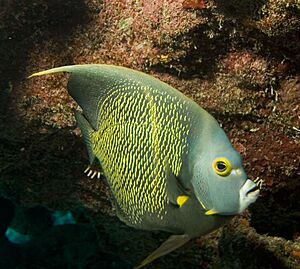French angelfish facts for kids
Quick facts for kids French angelfish |
|
|---|---|
 |
|
| Conservation status | |
| Scientific classification | |
| Synonyms | |
|
The French angelfish (Pomacanthus paru) is a beautiful fish that lives in the ocean. It's a type of marine angelfish and belongs to the Pomacanthidae family. You can find these colorful fish in the western Atlantic Ocean.
Contents
Appearance and Features
The French angelfish has a body that is almost round. It looks a bit flattened from side to side. Its head is deep, and it has a short snout with a small mouth. Inside its mouth are many bristly teeth.
This fish can grow up to about 41 centimeters (16 inches) long.
Young vs. Adult Fish
Young French angelfish, called juveniles, are mostly black. They have five bright yellow stripes going up and down their bodies. The first stripe is around their mouth. The last stripe is near their tail. The stripes on their body are curved. Their tail fin also has yellow edges.
Adult French angelfish are also mainly black. But most of their scales have a golden-yellow edge. They have a white mouth and a yellow ring around their eyes. Their pectoral fins, which are like arms, have a wide orange-yellow band. The dorsal fin on their back has a long, yellow, string-like part.
Where They Live
The French angelfish lives in the western Atlantic Ocean. You can find them from New York all the way down to Brazil. They also live in the Gulf of Mexico and the Caribbean Sea. This includes places like the Antilles and Roatan. They are also found in the eastern Atlantic around Ascension Island and St. Paul's Rocks.
Habitat and Daily Life
French angelfish live in the ocean at depths from about 3 to 100 meters (10 to 330 feet). They are often found on rocky reefs and coral reefs. You will usually see them swimming in pairs. They often stay close to sea fans, which are soft corals.
What They Eat
These fish eat many different things. Their diet includes sponges, algae, and small animals like bryozoans and tunicates. They also munch on gorgonians, hydroids, and coral.
Territory and Behavior
French angelfish pairs are very protective of their home area. They will strongly defend their territory from other fish. They are active during the day. At night, they go back to a special hiding spot to rest. If they get scared, they can make a knocking sound!
Cleaner Fish Role
Young French angelfish act as "cleaner fish." They set up special cleaning stations. Here, they remove tiny parasites from other fish. Many different fish come to them for cleaning. These include jacks, snappers, morays, grunts, surgeonfishes, and wrasses.
When a young angelfish wants to attract a client fish, it swims in a fluttering way. As it cleans, it gently touches the other fish with its pelvic fins.
Reproduction and Life Cycle
French angelfish pairs usually swim a short distance above the reef. It's hard to tell males and females apart just by looking at them.
When they reproduce, the pair swims upwards from the reef. They go up about 2 or 3 meters (6 to 10 feet). As they swim up, their bodies angle slightly, very close together. They hold this position at the top of their swim before separating as they go back down. Other angelfish pairs nearby might do similar movements at the same time.
An interesting fact about this species is that they are protogynous hermaphrodites. This means that a female fish can change its sex to become a male if there isn't a male present.
French Angelfish and Humans
The French angelfish is a popular fish in the aquarium trade. Many are caught and sent to the United States and Europe, especially from Brazil. They have also been successfully bred in captivity.
People also catch them for food. Their meat is considered very tasty. However, sometimes eating them can cause a type of food poisoning called ciguatera.



